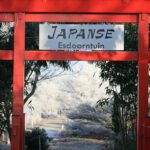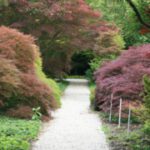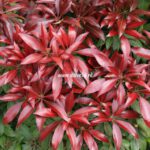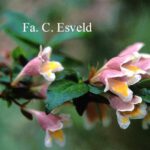
Aceretum
A part of the nursery is taken by our extensive Maple collection, consisting of almost all hardy species and a wide range of cultivars. We call this collection our ‘Aceretum’; it is very interesting during May and June, when the young leaves develop and in the autumn when the flaming colours make a wonderful display. We have expanded this collection into a new part of our nursery along with our collections of the genera Buxus, Pieris and Lonicera. The collection is larger and more interesting than ever before with well over 1000 different maples. We think that a visit to our nursery is worthwhile. (no boots necessary).
Dutch plant collections
On our nursery several of the Dutch Plant Collections can be visited. These Dutch Plant Collections are an initiative of the Royal Boskoop Horticultural Society (for more information see the website of the NPC. The Dutch Plant Collections on our nursery are: Acer ( the Aceretum, described above), Hydrangea, Buxus, Camellia, climbing Lonicera, Pieris, Enkianthus, Ilex, Abelia, Sarcococca, Osmanthus and Japanese Azalea. The collections are open to visitors free of charge during business-hours. A complete inventory of the collection is available and also updated when necessary on the Internet, it can be found at this page.
Acer
The Dutch Plant Collection of Acer is very large and has well over 1000 different species and cultivars. Very likely this is the largest collection of maples in the world at one location. The collection started in the 1960’s and about 1970 the name Aceretum was invented. De starting point for the collection was the extremely large specimen of Acer shirasawanum ‘Aureum’, then still known as Acer japonicum ‘Aureum’. This colossal plant is still the centerpiece of the collection and is now about 140 to 150 years old. This plant really shows its age by not growing anymore. Nobody knows how old this plant can get. The first plants of the collection were planted out in 1970 and already a few years later there were over 100 different planted. The interest in the species also grew and over the years many more were added to the collection. The Aceretum was planted as an arboretum and many paths were laid out. It now takes about 1 hectare. Now, 30 years after the start, many plants came to full maturity and the Aceretum now really breaths an oriental athmosphere. Some of the more notable specimens include Acer griseum, Acer buergerianum ‘Mistuba kaede’, Acer distylum, Acer pectinatum forrestii and many cultivars of Acer palmatum. Also many sometimes extremely rare species are present, such as Acer pentapomicum, Acer caesium, Acer pentaphyllum and Acer sterculiaceum ssp. thomsonii. In the course of the years many societies and other organisations visited the Aceretum. The high point in this was the visit by the International Dendrologicy Society in 1995 on the occasion of the Acer Symposium held that year in Wageningen and Boskoop. Many well-known dendrologists of the world were present at that occasion. The Aceretum is divided into two parts, the ‘Old’ Aceretum is the original part. The ‘New’ Aceretum was started in 1990 because the old part was totally full. In the new part also the collection Japanese Azalea was planted, a winning combination as it turned out. Also a long border with mostly German Rhododendron cultivars is planted here. This new part has been completely renovated in the winter 2004-2005. The entire list is here.
Japanese azaleas
This collection is only a few years in the making, but already about 200 different cultivars are planted out. The origin of the Japanese Azaleas is obviously Japan, but also Germany has produced quite a few different hardy cultivars. The old garden culture in Japan made for many interesting cultivars. Most of the small-flowered cultivars originate directly or indirectly from Rhododendron kiusianum. These are often called the Kurume-Azaleas. By far not all come from Japan. Those with European-style cultivar names mostly originated in England and The Netherlands. The cultivars from the USA are less well-known in Europe, but quite a few are present here. The Japanese Azaleas come in a wide range of flowers, but there are no blues and yellows. These colours can be found in the dwarf Rhododendrons and can be distinguished easily by their 5 instead of 10 anthers. At the International Exhibition Floriade 1992 an impressive showing of Japanese Azaleas was present, mainly consisting of new varieties unknown in Europe. This collection could be purchased after the show and is now a cornerstone of the Dutch Plant Collection Japanese Azalea. In the collection some very special varieties are also present, like ‘Linearifolium’ with linear flowers and a collection of ground covering, late flowering (June) cultivars of Rhododendron nakaharae. The variety ‘General Wavell’ has the largest flowers of all. A phantom name in the Japanese Azaleas is Rhododendron obtusum, which in fact does not exist at all. This name is used as a common denominator for those cultivars which cannot be put with their right parents. The higher growing and large-flowering cultivars mostly originate from Rhododendron kaempferi and Rhododendron ‘Malvatica’, which was used extensively for breeding new varieties. The collection forms part of the Aceretum described above. Recent information in English on Japanese Azaleas is hard to find. Collection list is here
Enkianthus
This small genus contains 10 species, of which only Enkianthus campanulatus is well known and used. This very variable species is grown from seed and those seedlings yielded several very nice cultivars. The best are those whose names all start with a ‘V’: ‘Victoria’, ‘Vega’, ‘Vesta’ and ‘Virgo’. A small collection is now planted as part of the Aceretum. The autumn colours are almost always spectacular Recently a large article was published in Dendroflora Nr. 31, which also has an English summary. List of the collection here
Hydrangea
Hydrangea macrophylla is the best known group in Hydrangea and in this group there are many hundreds of cultivars introduced in Europe, Japan and America. Many of these are planted in the Aceretum as borders in various parts of this garden, where also the collection of climbing Lonicera is located. But not only in the Aceretum, there are several places in the nursery where groups of these are planted together, from evergreen climbing varieties in the hollies to a large group of Hydrangea paniculata and close relatives. We are proud of the extensive collection of the Japanese mountain-varieties of which the tea-variety is the best known. About half of the about 400 different Hydrangeas are in the Hydrangea macrophylla group, the other half belong to the many other groups in Hydrangea including a great number of less-known species and cultivars. A complete inventory is found at hier.
Pieris
The collection of Pieris contains only very few species, but many cultivars. In the 1980’s and 1990’s this collection was assembled and after 4 years of judging by the Royal Boskoop Horticultural Society, the sponsor of the Dutch Plant Collection, the entire collection was judged. The results of this were published in Dendroflora Nr. 31, which has an English summary. Pieris is long-flowering and their dormant flowerbuds are already attractive long before they open, often already showing before winter sets in. The flowers open late March with small, almost always white, but also pink and red bells hanging on more or less large trusses. Nowadays Pieris is not only used in gardens, but also indoors and in large containers. The young growth is often red or shiny brown and is very attractive. The collection now contains about 70 different species and cultivars. The list is here
Osmanthus
The collection of Osmanthus is, certainly when the limited number of species is taken into consideration, quite complete. By far the best known species is Osmanthus heterophyllus, also known by their synonyms Osmanthus ilicifolius and Osmanthus aquifolium. Both synonyms refer to their resemblance to the hollies. There is one aspect however, which makes confusion between the two impossible. The leaves of Osmanthus are opposite, where the leaves of Ilex are not. Also Osmanthus does carry berries, but these are blue-black. The flowers of Osmanthus are very fragrant. In Osmanthus heterophyllus about 10 cultivars are known, all present in the collection. The various other species known are present with their cultivars where they exist. Very conspicuous is Osmanthus delavayi with its tiny leaves en extremely fragrant flowers in spring. Even Osmanthus yunnanensis with its very large leaves survives our climate, although in severe winters it dies back somewhat, but recovers in spring. In total about 25 different species and cultivars are to be admired here. List is here
Buxus
This collection started in the early 80’s out of curiosity to the remnants of a flourishing Buxus culture earlier in the 20th Century. Many of the then cultivated cultivars of Buxus sempervirens were in danger of disappearing, many of the different cultivars were only still present in old gardens and estates. Later, in the middle of the 80’s, the interest in Buxus widened to the other species in this interesting genus. Especially the nomenclature proved to be a challenge. The collection that grew out of this interest and desire to collect them all resulted in 125 different named species and cultivars of hardy Buxus. The plants in our collection are never cut back and thus show their natural habit. The collection is now a nearly complete overview of all forms of Buxus available in Europe. The entire list of the collection is available here. The mere existence of the collection has been the reason of several publications about Buxus in the last few years. The collection is located at the beginning of the Aceretum, all plants are clearly labeled and can easily be used as a base reference.
Climbing Lonicera
Since 1992 is the collection of climbing Lonicera part of the New Aceretum. There exist about 50 species of climbing Lonicera, all on the Northern Hemisphere. Most occur in Asia, from East India to China and Japan, south to Sumatra and Java. Climbing Lonicera is divided into two subgenera, Chamaecerasus and Caprifolium. In the subgenus Chamaecerasus the flowers are always in pairs together, from the leaf axils, see Lonicera japonica. In the subgenus Caprifolium the flowers are in one or more close clumps, see for instance Lonicera periclymenum. Some species are evergreen or semi-evergreen, many are very fragrant. The colours of the flowers vary from white, cream, yellow to red, the berries are usually black, red or orange. Of the about 30 Asian species 11 are present in the collection, among them the very rare Lonicera macranthoides. In North America 12 species occur, also 9 are present in the collection, including the very rare species Lonicera pilosa from Mexico. The 6 European species are all present. The entire collection now consists of 25 species, 7 hybrids and 37 cultivars. More information can be found at the website of our employee, Mr. A. Laros, who initially formed and maintains the collection at the address www.lonicera.nl, this site is both in dutch and in english. The list of what is in the collection is here
Abelia
The collection Abelia is the latest in the growing number of collections we maintain. Out of curiosity to mainly the winter hardiness of these elegant summer flowering shrubs we formed a sizable collection of them and planted them outside in the Garden Center near the glasshouse to protect them mainly from the wind. That protection proved mostly to be unnecessary as they were hardier than expected. Some did freeze back somewhat but that only saved us the work of pruning them. Especially in mid-summer the number of flowering shrubs is not so high and these Abelia’s are therefor a welcome addition to the summer garden. The entire list is here
Sarcococca
The new Sarcococca collection is a ‘relative’ of the Buxus-collection that we already have for many years. The genus is closely related, both are part of the Buxaceae. It is a genus of which the nomenclature and classification always have been unclear. Partly thanks to our employee Arjan Laros who made a study of the genus, resulting in a scientific paper in Dendroflora, more clarity has emerged. In the past 20 years we have now collected most species and cultivars of Sarcococca and now they have been successfully identified and named. The collection comprises of over 10 species and cultivars and that makes it virtually complete. Interesting to see was that also the larger Asian species as Sarcococca orientalis and wallichii proved to do rather well in our climate. Especially the orientalis which has, like all other species, richly scented flowers appears to be an asset to the assortment of available species. Nice evergreen and well-scented small plants can be put to very good use in the garden! Inventory list hier.










